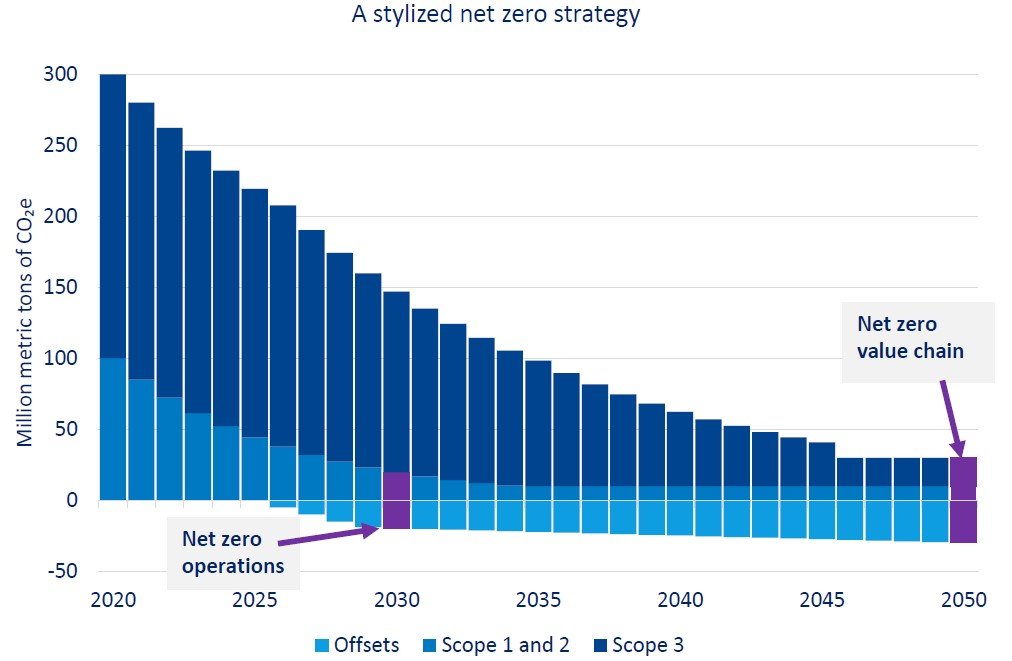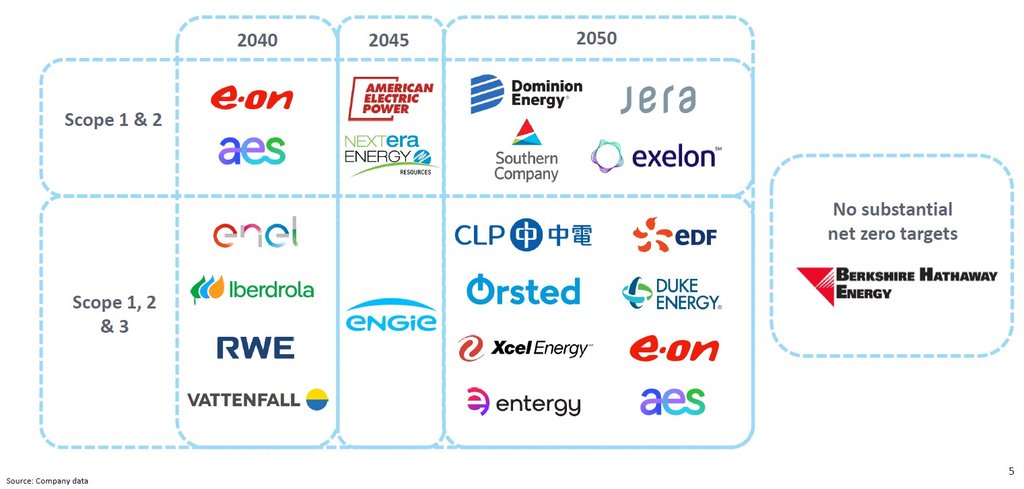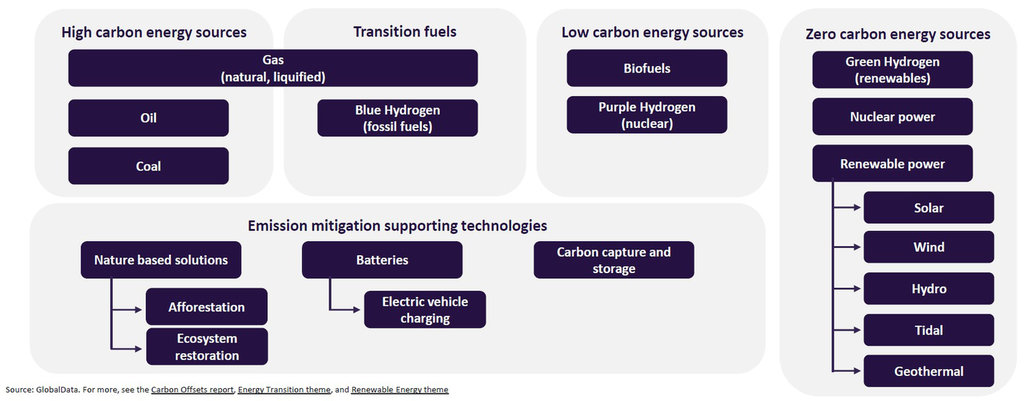power generation through fossil fuel combustion is the leading source of greenhouse gas (GHG) emissions across the power sector. Power companies should prioritize phasing out coal fired power generation and transition towards renewable and low carbon sources if they hope to achieve net zero targets.
Power companies should avoid investing in carbon offsets when establishing their net zero strategies. Directly reducing the total carbon within portfolios through clean technologies will be a more effective method of sustainably reducing net carbon emissions by target dates. Companies leading the decarbonization race invest heavily in wind and solar power plants to reduce net emissions.
The emissions ratio across the industry is split predominantly between Scope 1 and Scope 3 emissions, with Scope 2 only accounting for 3 of all emissions. The main contributors to these emissions are using fossil fuels to generate electricity (Scope 1) and the use of non-renewable gas by end users (Scope 3).
Energy storage will play a key role in grid balancing during the renewable transition. Investing in energy storage will help to manage the intermittency of renewable energy and deliver a supply to the grid that meets consumer demand.
Investing in smart grids and integrating AI supported predictive maintenance technologies at all points along the supply chain will help with energy demand management and reduce energy losses.
What are net zero emissions?
Net zero means cutting greenhouse gas emissions (GHG) to as close to zero as possible, with any remaining emissions then ‘offset’. Firms that achieve net zero emissions may say they are ‘carbon neutral’.
Companies typically first aim to achieve net zero operations by reducing their Scope 1 and 2 emissions and purchasing offsets. They can then achieve net zero value chains by reducing their Scope 3 emissions and purchasing offsets to offset the remainder. For most companies, Scope 3 is the largest and most difficult to measure and reduce.
Emissions are offset by supporting projects that reduce emissions or remove greenhouse gases from the atmosphere.
Companies are under pressure to cut emissions as countries aim to achieve their climate commitments. Every major economy has signed up to the Paris Agreement, the global climate agreement that commits signatories to keep global warming well below 2C above pre-industrial levels.

Who is winning the race to net zero?
Most power leaders have set net zero targets, but few include Scope 3 emissions. GlobalData has analyzed the targets, emissions data, and net zero strategies of 20 leading power companies.

The leading companies based on GlobalData’s Energy Transition ranking are shown below.

Renewable energy transition needs to be the priority
Power companies must prioritize transitioning their energy generation sources towards renewable and low-carbon options if they hope to achieve net zero targets.
Power generation through fossil fuel combustion is the leading source of GHG emissions across the power sector.
Transitioning to renewable sources of energy generation will greatly reduce not only the Scope 1 emissions produced from company operations but also mitigate the Scope 3 emissions associated with the use of generated energy sold to end users.
Leading companies, such as Ørsted, that have prioritized adapting their business structure towards predominantly selling renewable energy have significantly reduced both their Scope 1 and Scope 3 emissions.
Once online, renewable power plants have lower production overheads than fossil-fuel power plants. Many regions (including the EU, UK, and US states) still operate based on the merit order system, when setting wholesale electricity prices. Which has resulted in strong incentives for companies to supply renewable energy.
Leading companies focused on zero carbon energy production can benefit greatly in the short term due to the higher wholesale cost assigned to electricity supplies. This provides further financial incentives to invest in carbon-free energy sources and decarbonize energy portfolios.
This episode of our podcast discusses the current state of sustainability commitments in the power, oil & gas, and mining sectors, and how companies are working to reduce their environmental impact.
The power sector energy transition value chain
Companies looking to achieve their net zero goals need to decarbonize their fuel sources and transition to zero-carbon energy sources.
The first stage of the energy transition involves fuels such as natural gas, liquefied natural gas, and blue hydrogen, which act as transition fuels. The use of transition fuels is gaining momentum as they provide a way of ensuring energy security for the short term while fulfilling energy transition commitments over a longer time horizon. However, these still are carbon-emitting energy sources.
Dependency on transition fuels will persist until cleaner energy fuels are deployed and become more economically reliable. Heavy industries such as petrochemicals, steel, and cement are expected to rely on transition fuels before adopting cleaner fuels.
However, COP28’s headline deal pledged a global ‘transition away from fossil fuels in energy systems’ after much dispute, suggesting greater pressure looming for the energy sector to decarbonize.

Renewable energy transition strategies
Renewable energy, energy storage, hydrogen fuels and smart grids are key components in the renewable transition.
Renewable energy
One of the key achievements of COP28 was a pledge to triple renewables and double the rate of energy efficiency by 2030. It has so far been signed by over 120 countries, including the EU and US (though not India and China), and the EU has assigned $2.5 billion from its budget to support the energy transition in the next two years.
The two most prominent renewable sources that leading power company investments have been directed toward are solar and wind energy generation.
Key strategies in renewable energy:
- Powering offshore platforms using cleaner grid power or on-site renewables, like offshore wind farms.
- Develop green hydrogen production facilities and associated pipeline technologies.
- Phase-out of fossil fuel-based assets. Immediate attention to the decommissioning of coal-fired power production and lignite-based energy generation.
Energy storage and hydrogen fuel
Energy storage in batteries and hydrogen fuel will play a crucial role in capitalizing on the potential of renewable energy sources.
It is particularly important for the development and integration of renewable energy technologies. Energy storage plays a key role in grid balancing, helping to manage the intermittency of renewable energy and deliver a supply to the grid that meets consumer demand.
Investment into industry has continued to evolve and adapt to changing energy requirements and advances in technology. It needs to focus on reducing the costs to make the inclusion of storage alongside renewable projects more viable.
Hydrogen gas is light, storable, and does not produce direct carbon emissions or greenhouse gases (GHG) when combusted. Hydrogen fuel can be produced from numerous energy sources such as natural gas, and nuclear power, and renewable energy sources such as biomass, wind, and solar power. It can be used as a clean fuel that2 does not emit CO₂ on combustion and offers great potential as a petrol and diesel alternative across the wider industrials sector.
Smart grids
Integrating smart grid technology will be essential in managing renewable energy supply and meeting grid demands.
Power generation from renewable energy resources will continue to grow due to the pledge for net-zero carbon emissions by 2050, however, the present energy grid structure will not sustain this goal as it offers limited flexibility to support these emerging renewable technologies.
To support and drive an efficient integration of renewable technologies, electrical grids must be transformed into smart grids through digital infrastructure.
The implementation of a smart grid will lead to a highly distributed and digitized network of clean renewable energy. Smart grid technology will enable the effective management and distribution of renewable energy sources such as wind, solar, and hydrogen by connecting them to various distributed energy resource assets across the grid.
The growing demand for power generation through renewable energy resources will eventually push the global economies to modernize their grid and make it smarter for better accommodation and distribution of clean energy. However, power companies should invest in integrating smart grid technologies into their up and downstream supply chains.
For more insights into the path to net zero for companies, buy GlobalData’s report Net zero strategies in the power sector.
GlobalData, the leading provider of industry intelligence, provided the underlying data, research, and analysis used to produce this article.
GlobalData’s Thematic Intelligence uses proprietary data, research, and analysis to provide a forward-looking perspective on the key themes that will shape the future of the world’s largest industries and the organisations within them.
